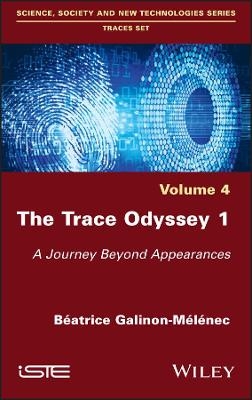
The Trace Odyssey 1
ISTE Ltd and John Wiley & Sons Inc (Verlag)
978-1-78630-551-0 (ISBN)
This didactic book presents a contemporary exploration of the fundamental nature of the trace via the new French paradigm of the �Ichnos-Anthropos� (�Homme-trace�) and its corollary, the �corps-trace�.
Béatrice Galinon-Mélénec is an Emeritus Professor in Information and Communication Sciences at Normandy University Le Havre, France, and research director at the CNRS-IDEES 6266 laboratory. She founded and co-directs the e-Laboratory on Human Trace in the UniTwin UNESCO Complex Systems Digital Campus.
Acknowledgements ix
Introduction: Establishment of the Roadmap xi
Chapter 1. Beyond the Triviality of the Trace 1
1.1. Preamble 1
1.2. Contact traces 3
1.2.1. “Corps-trace” and Locard’s principle 3
1.2.2. Technology-assisted papillary trace reading 4
1.2.3. Animals, readers of the primary traces of humans 5
1.3. Humans, readers of traces bearing witness to the passage of animals 6
1.4. Technology at the service of deferred interpretation 7
1.4.1. Conséquences-traces of the action by the “operator” and the “spectator” 8
1.4.2. Punctum 8
1.4.3. Emotional interference in interpretation 9
1.4.4. Part of the invisible 10
1.4.5. Authentication of photographic representation 10
1.4.6. Automatic recording and its evidentiary value 10
1.5. Techne as a trace of the evolution of “Homme-Trace” 11
1.6. Trace visibility and invisibility 11
1.6.1. Questioning our current perception of reality 11
1.6.2. Example in the criminal domain 12
1.7. Digital application 13
1.8. The interaction between milieu, traces from the body and “corps-trace” 15
1.8.1. Conséquences-traces without an apparent physicality 15
1.8.2. Uncontrollable emersive signes-traces 16
1.8.3. Return of the repressed 16
1.8.4. Trauma traces 17
1.9. Conclusion: beyond the natural character of the trace 17
1.10. Bibliography 18
Chapter 2. Gateway to the Digital World 21
2.1. Preamble 21
2.2. Role of attention 22
2.3. Identifying the trace 23
2.4. Specificity of the digital trace 24
2.5. Digital universe, a space designed by humans 26
2.6. Rules of a digital society 27
2.7. Capta before data 28
2.8. Transforming capta into data 30
2.9. Reading data 30
2.10. Risks associated with uncoupling and interpretation 31
2.11. Conclusion: mute data and interpretative risks 32
2.12. Bibliography 34
Chapter 3. The Lettrure from Yesterday to Today 35
3.1. Preamble 35
3.2. From reading the heavens to the power of the cartographer 35
3.2.1. Ancestral rock writing 36
3.2.2. Power of the cartographer 37
3.3. Key role of the dominants interprétatifs 37
3.4. Algorithms behind the screen 38
3.5. Humans behind the algorithm 39
3.6. Individuation of meaning 39
3.7. Considering writing as a trace of an absence 40
3.8. Writing at the expense of the lettrure 40
3.9. Traduttore, traditore 42
3.10. Example of a chaining of conséquences-traces 43
3.11. Mechanisms of the ecosystem of electronic traces and digital humanities 44
3.12. Conclusion: role of humans in the cogs of the digital ecosystem 47
3.13. Bibliography 48
Chapter 4. Understanding Traces with Forensic Science 53
4.1. Preamble 53
4.2. Self-learning machines and open-source software 56
4.2.1. Performance of self-learning machines 56
4.2.2. Double face of techne 57
4.3. Trace and forensic science 58
4.4. Role of circumstances in the indexing of meaning 59
4.5. Trace collection and indexing of meaning 60
4.6. Collected traces and classification inventory 62
4.6.1. Cases of DNA transfer 66
4.6.2. Technical progress to identify traces in the bodies of criminals 67
4.6.3. Being accountable to interpretations 67
4.7. Discretization and bias 68
4.8. Conséquences-traces of the choice of indices 70
4.9. The embodied semiotics of the investigator 72
4.10. Intrinsic embodied semiotics of each Investigator 73
4.11. Conclusion: of human beings, technology, and interpretation 75
4.12. Bibliography 78
Chapter 5. A Complex Dynamic Process 81
5.1. Preamble 81
5.2. New milestone 82
5.3. Veiled Real 84
5.4. Consequences of semiotic choices 89
5.5. Assumptions related to the term signe-trace 93
5.5.1. Muteness of the trace 93
5.5.2. Discretization of the Real by humans 94
5.5.3. A human being considered as a Homme-trace 94
5.6. Difference between each homme-trace 96
5.7. Relationship with digital space 97
5.8. Interactions and relationships at the heart of processes 98
5.9. Conclusion: signes-traces and abductive reasoning 99
5.10. Bibliography 103
Conclusion: The Ichnos-Anthropos 107
Glossary 131
References 135
Index 147
| Erscheinungsdatum | 11.05.2021 |
|---|---|
| Verlagsort | London |
| Sprache | englisch |
| Maße | 10 x 10 mm |
| Gewicht | 454 g |
| Themenwelt | Naturwissenschaften ► Biologie |
| Sozialwissenschaften ► Pädagogik | |
| ISBN-10 | 1-78630-551-8 / 1786305518 |
| ISBN-13 | 978-1-78630-551-0 / 9781786305510 |
| Zustand | Neuware |
| Haben Sie eine Frage zum Produkt? |
aus dem Bereich


